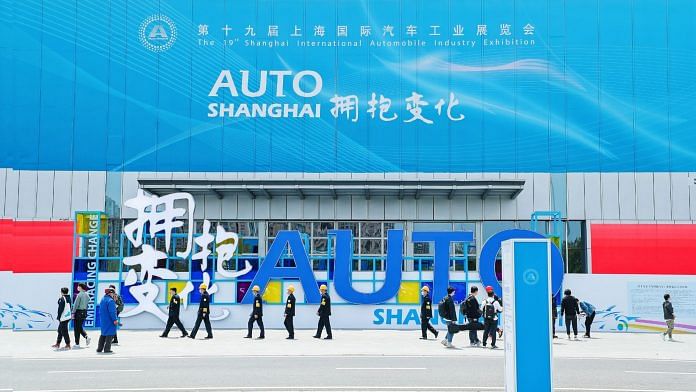I love reading ThePrint’s articles on China by the columnist Aadil Brar, through whom I discovered the equal parts racist and hilarious safety videos put out by the Chinese police. However, perhaps because of the events happening on our Western border over the past week, I did not see much coverage of arguably one of the most important events in China in recent weeks, neither in ThePrint nor in any other Indian publication. No, it wasn’t related to the upper echelons of the Chinese Communist Party. The event I am talking about was the recently held Shanghai Auto Show.
China is the world’s largest car market, with sales just short of 27 million units in 2022, almost seven times the size of the Indian car market. There are more cars from German luxury brands Audi, BMW, and Mercedes sold in China every year than the total number of cars sold in India. German companies like Volkswagen AG that made an early bet on China back in the 1980s depend on the Chinese market for half of their annual revenues and profits. More importantly, this auto show was the first major event in China after the country lifted its severe entry restrictions for Covid.
And most Western carmakers were in for a shock: Chinese carmakers had gone a long, long way forward. While many in the developed world are talking about strict mandates for zero emissions vehicles, proposing banning the sales of internal combustion engine (ICE) cars by the 2030-2040 timeframe, their carmakers have struggled to adapt. One reason for this struggle is that many of these companies have not managed to balance the urge to sell ICE vehicles and develop a whole new electric vehicle ecosystem.
Also read: China censors citizens from discussing Pakistan protest. Political revolt is a sensitive topic
It’s China’s time now
For years, many Western as well as Korean and Japanese companies used their traditional knowledge of engineering automotive products to their advantage. After all, a car is not just an amalgam of parts but also tuning the suspension and engine, skills more from the ether rather than anything else. Electric vehicles upended the market, and that is something you can notice in India as well with the rise of brash and confident start-ups in the electric two-wheeler space. But in cars, this has allowed the Chinese companies to not only play catch-up but as the products that stole the show at Auto China prove, overtake traditional carmakers.
And while Indian buyers might be aware of companies like Shanghai Automotive Industrial Corporation (SAIC) that sells cars under the MG brand in India but use the Roewe and Wuling brands in China as well as BYD, which is quickly becoming the largest EV manufacturer in the world, they would likely have not heard of some of the following. Polestar, a sub-brand of Swedish carmaker Volvo, which itself is owned by Chinese giant Geely, which also owns the high-end brand ‘Lynx & Co’. There is also Xpeng, Yangwang, Dongfeng, and HiPhi.
Their products look good and perform well. It is in the rise of these Chinese carmakers that an automotive journalist like me can appreciate Chinese industrial policy and its outcomes.
China has religiously followed a path towards vehicle electrification and while it might have begun with cheap electric cycles, it has evolved into a policy of securing natural resources such as Lithium, controlling the processes around it but also focussing scientific and technological development in this space. It is China that generates a bulk of the intellectual property around battery chemistry, charging technologies and it is China that is developing the next-generation of battery chemistries such as Sodium-Ion chemistries. Western car company executives who went to Auto China saw this and are now petrified of the oncoming Chinese electric onslaught.
It is possibly this fear of China that the Indian automotive industry could potentially leverage, although even the electric cars sold by ostensibly Indian manufacturers use Chinese batteries and software. But it will be geopolitics and geoeconomics that plays a larger role in the global automotive industry as China races to become the largest car exporter in the world. Joe Biden’s ‘Inflation Reduction Act’ (IRA) aims to promote manufacturing in America and rising protectionism in Europe while the Russia-Ukraine conflict continues in the background.
The automotive space is getting interesting for all the right and wrong reasons currently, and maybe it makes you long for the days of yore.
This article has been updated to reflect a correction.
@kushanmitra is an automotive journalist based in New Delhi. Views are personal.
(Edited by Prashant)



